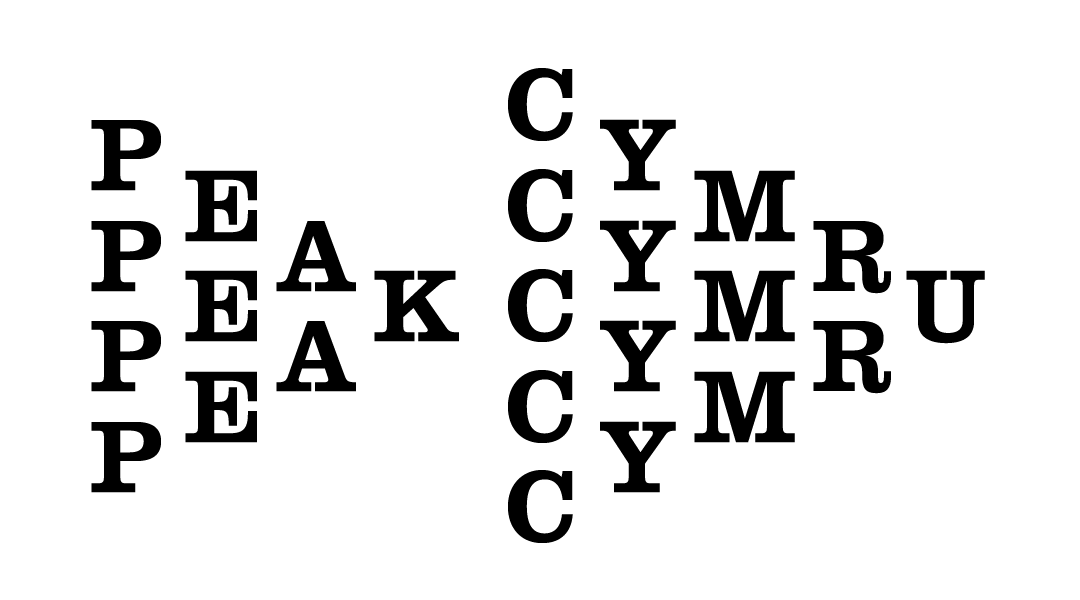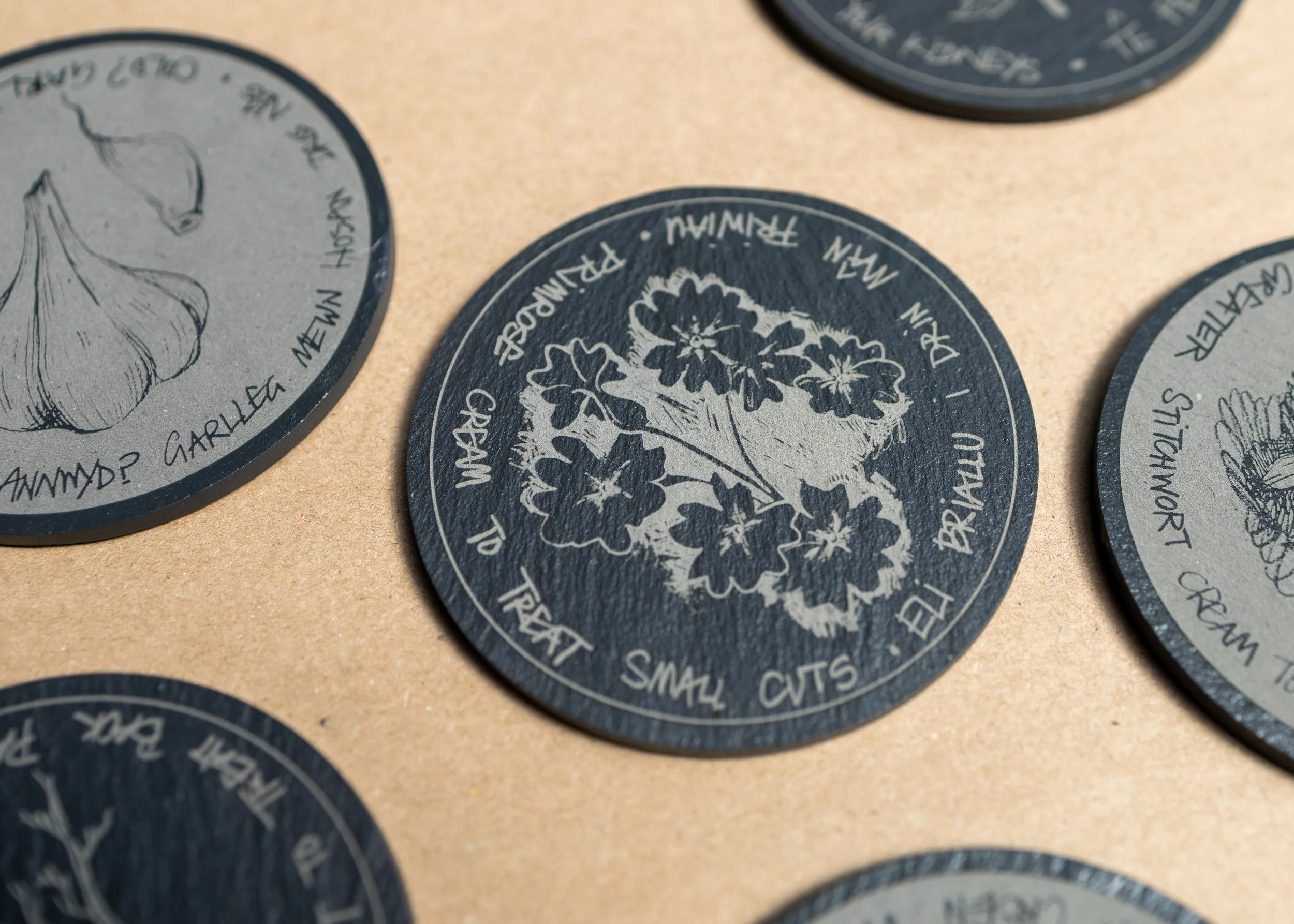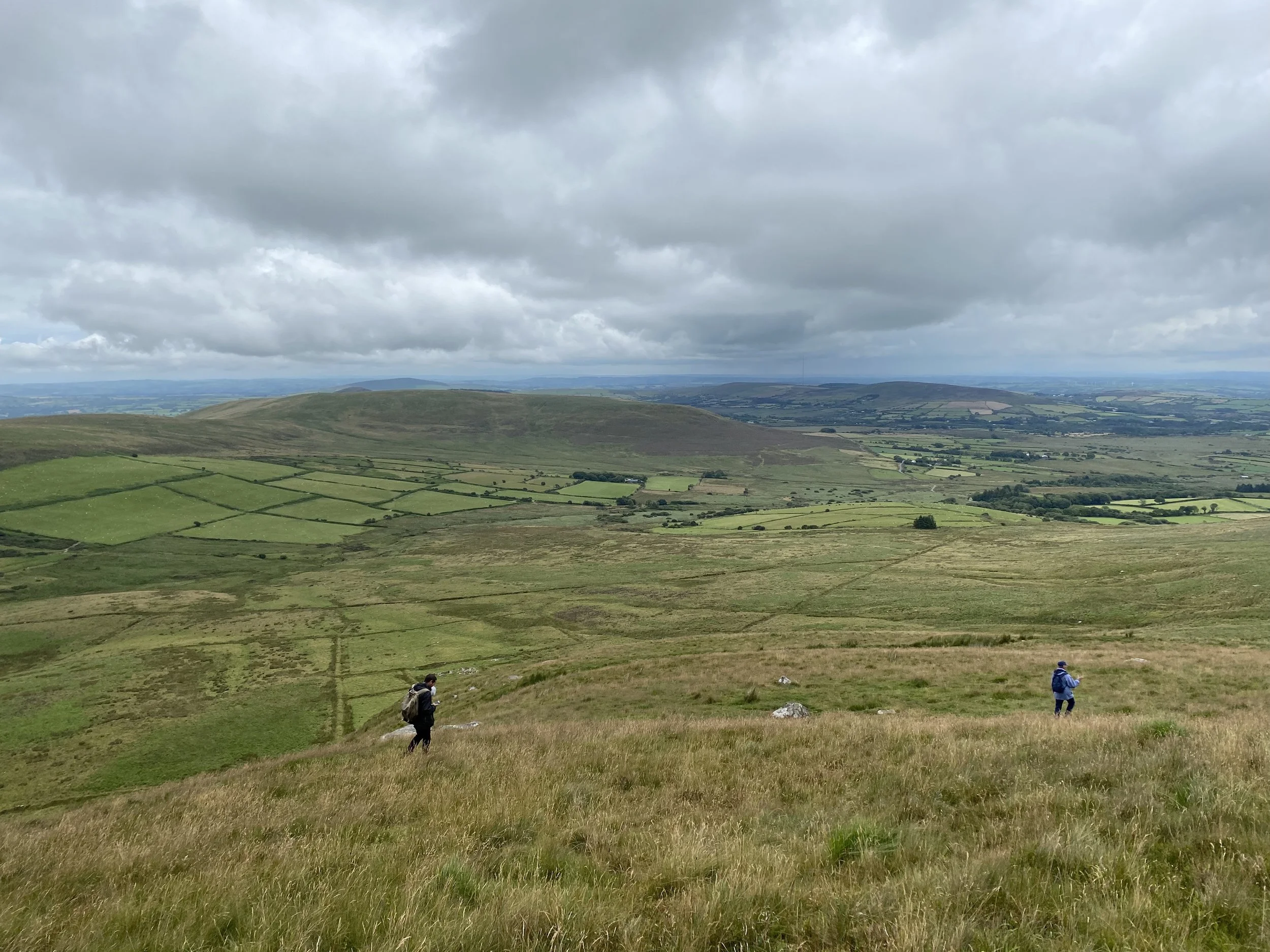Comisiynau | Commissions
Y Fenni Community Feast Commission
Peak partnered with Abergavenny Food Festival and The Angel Bakery for this year’s Abergavenny Community Feast, which took place in the town’s Market Hall on 14th May 2023. We commissioned an original artwork by the artist and gardener Gwenllian Spink to respond to the Feast’s theme of ‘The Kitchen Garden,’ celebrating the joys of local produce. Gwenllian, with whom we previously collaborated on last year’s Pegwn and Platfform Haf programmes, responded to the brief by looking to oral histories of folk remedies embodied in Welsh-speaking communities. She created 300 drinking coasters on Snowdonia slate, adorned with intricate drawings of herbs and vegetables, which were designed for all the Feast’s attendees to take home with them. We also present a new text by writer and Peak Associate, Dylan Huw, which introduces Gwenllian’s work and some of the research and dialogue behind it.
Gweithiodd Peak gyda Gŵyl Fwyd y Fenni a becws yr Angel eleni ar Wledd Gymunedol y Fenni, a ddigwyddodd yn Neuadd Farchnad y dref ym mis Mai am y tro cyntaf. Gwahoddom yr artist-arddwr Gwenllian Spink, a fuodd yn rhan o raglenni Pegwn a Platfform Haf llynedd, i greu gwaith celf gwreiddiol byddai’n ymateb at thema’r Wledd, ‘Y Gegin-Ardd,’ a dathlu cyfoeth cynnyrch lleol. Ymatebodd Gwenllian wrth edrych at hanesion llafar o feddyginiaethau gwerin mewn cymunedau Cymraeg. Crëodd [how many?] o fatiau diod ar lechi Eryri, â darluniadau cywrain o lysiau a pherlysiau arnynt, i bawb yn y Wledd gael cymryd adref. Ochr-yn-ochr â chomisiwn Gwenllian mae ysgrif byr gan y sgwennwr Dylan Huw, sy’n un o gymdeithion Peak, i gyflwyno’r gwaith a’r ymchwil a’r ddeialog tu ôl iddo.
Roedd rhinwedd neilltuol yn perthyn i law mis Mai
ac, yn arbennig, i law cyntaf Mai.
May rainfall, and May’s first in particular, has been known to possess all kinds of medicinal properties: to improve eyesight, to clean bruises, to kill cattle lice. Gwenllian Spink, an artist and gardener living in Nant Ffrancon, has taken inspiration from these and other Welsh folk remedies for an edition produced especially for today’s community feast. The commission, on Snowdonia slate, is informed by Anne Elizabeth Williams’ Meddyginiaethau Gwerin Cymru, which maps just some of these largely unrecorded salves, which are micro-locally rooted and intertwined with Welsh-language oral inheritances. For back pain, boil rhubarb root or a blackcurrant branch; if you have a cold, sleep with garlic in a sock and allow it to work its magic. Gwenllian’s gentle translation of some of these remedies onto slate asks that we consider not just where our produce comes from but what kinds of lineages of community knowledge it might contain. It asks too that we pay respect to embodied histories that evolve outside the strictures of dominant cultures—and that we enjoy the meal.
Gwyddwn i ddim tan yn ddiweddar bod rhai’n credu bod gan law cyntaf Mai bŵer unigryw i olchi briwiau, gwella llygaid gwan a lladd llau gwartheg. Ar achlysur gwledd heddiw (yn ogystal â glaw Mai, a dyfodiad yr Haf), mae Peak wedi comisiynu gwaith newydd gan yr artist-arddwr Gwenllian Spink. Trodd at ymchwil Anne Elizabeth Williams ar gredöau lleol Cymreig am rinweddau meddygyniaethol llysiau a pherlysiau, sydd wedi’u gwreiddio mewn ardaloedd penodol o Gymru a thraddodiadau llafar Cymraeg. Berwch wreiddiau riwbob neu gangen cyrans duon i wella poen cefn; cysgwch gyda garlleg mewn hosan i ddod dros annwyd. Mae cyfieithiad Gwenllian o rai o’r rhwymedi at lechen yn gofyn ein bod ni’n ystyried yr etifeddiaethau cymunedol a lleoliad-benodol mae pob darn o fwyd, a thir, yn cario. Mae’n gofyn hefyd ein bod ni’n talu teyrnged at ffurfiau ymgorfforedig o hanes, tu hwnt i ddiwylliant unffurf—a’n bod ni’n mwynhau’r pryd.
Dylan Huw
LUMIN
carve, hew, adze, bend, weave, grow, split, join
Platfform 2: July 11- August 8 | 11 Gorffennaf - 28 Awst
‘carve, hew, adze, bend, weave, grow, split, join is a work of speculative fiction about an autonomous community in a countryside of the future. Drawing on the interdependence of country and city as well as past revolutions in rural craft, it considers the tools, objects and methods of a woodworkers' coop after the decline of the metropolis. Alongside this, a quote from postcolonial theorist and poet Édouard Glissant similarly rejects the countryside as solely a place of conservatism, alternate histories suggest that ‘the countryside is also the place where there are revolutions’. - LUMIN, Sadia Pineda Hameed and Beau W Beakhouse
Poster box Commission | Comisiwn Poster mewn Ffrâm
LUMIN are a small press, radio and curatorial collective - supporting new and established artists, writers and cultural practitioners in work that is radical, personal and experimental. Based in Cardiff, LUMIN is run by artists Sadia Pineda Hameed and Beau W Beakhouse, forming a wider collective with their regular collaborators.
Casgleb guradurol, radio a gwasg fach yw LUMIN - sy’n cefnogi artistiaid, awduron ac ymarferwyr diwylliannol newydd a sefydledig gyda gwaith sy’n radical, yn bersonol ac yn arbrofol. Wedi’u lleoli yng Nghaerdydd, caiff LUMIN ei rhedeg gan yr artistiaid Sadia Pineda Hameed a Beau W Beakhouse, gan ffurfio casgleb ehangach gyda’u cydweithwyr rheolaidd.
As part of Casgleb, LUMIN are researching ideas and structures of autonomy, exploring what an autonomous space in the arts (and for creating together) is and how autonomy relates to the different areas of their practice. In general, autonomy means to be self-governed, and in this context, LUMIN are approaching autonomy as a means of finding a way beyond oppressive systems past and present.
Fel rhan o raglen Casgleb, mae LUMIN yn ymchwilio i syniadau a strwythurau ymreolaeth, gan archwilio beth yw ystyr gofod ymreolaethol yn y celfyddydau (ac ar gyfer cyd-greu), a sut mae ymreolaeth yn ymwneud â gwahanol feysydd eu harfer. Yn gyffredinol, mae ymreolaeth yn golygu hunan-lywodraethu, ac yn y cyd-destun yma, mae LUMIN yn edrych ar ymreolaeth fel dull o ddod o hyd i ffordd y tu hwnt i systemau gormesol ddoe a heddiw.
Commissioned by Peak, this is the second in a series of poster box commissions which will gently share artist works and research emerging from Casgleb, on Platfform 2, Abergavenny Train Station. Casgleb is supported by the Arts Council of Wales’ Connect and Flourish fund.
Marva Jackson Lord
Ecosystem and Meditation on Multilingualism
Ecosystem a Myfyrdod ar Amlieithrwydd
Poster box Commission | Comisiwn Poster mewn Ffrâm
Platfform 2: June 10th - July 4th | 10 Mehefin - 4 Gorffennaf
Ecosystem and Meditation on Multilingualism are two new works by Marva Jackson Lord reflecting on voice, language and the realities of being a Black woman living in this part of rural Wales. In the pair of works, Marva centres her own silhouette in the landscape, evoking invisible histories of Black people in perceived white environments.
Dau ddarn newydd o waith gan Marva Jackson Lord yw Ecosystem a Myfyrdod ar Amlieithrwydd, sy’n myfyrio ar y llais, iaith, a realiti bod yn fenyw Ddu sy’n byw yn y rhan yma o gefn gwlad Cymru. Yn y ddau ddarn, mae Marva’n gosod ei silwét ei hunan yn ganolog yn y tirlun, gan ddwyn i gof hanesion anweledig pobl Dduon mewn amgylcheddau a gaiff eu hystyried yn rhai gwyn.
In developing this work, Marva wove together her first memory of hearing Cymraeg, when she thought she was hearing Jamaican Patois, with her personal relationship to landscape. Mapping Jamaica's Blue Mountains onto the Brecon Beacons, Marva traces linked histories and colonial legacies, underpinned by her long-term exploration of language, emotional memory and her deep personal connection with the land which has been her home for twenty years.
Wrth ddatblygu’r gwaith yma, plethodd Marva ei hatgof cyntaf o glywed y Gymraeg, pan oedd hi’n meddwl mai Jamaiceg roedd hi’n ei chlywed, gyda’i pherthynas bersonol gyda thirlun. Gan fapio Mynyddoedd Gleision Jamaica ar Fannau Brycheiniog, mae Marva’n olrhain hanesion cysylltiedig a gwaddol trefedigaethol, ac yn sail iddynt, ei harchwiliad hirdymor o iaith, cof emosiynol, a’i chysylltiad personol dwfn gyda’r tir sydd wedi bod yn gartref iddi ers ugain mlynedd.
Commissioned by Peak and Pegwn, this is the first in a series of poster box commissions which will gently share artist works and research emerging from Casgleb, on Platfform 2, Abergavenny Train Station. Marva Jackson Lord is a Canadian-Jamaican artist based in the Brecon Beacons, whose work across poetry, sound and digital media explores landscape and fantastical narratives. Casgleb is supported by the Arts Council of Wales’ Connect and Flourish fund.
Mae hi wedi’i chomisiynu gan Peak a Pegwn, a dyma’r cyntaf mewn cyfres o waith comisiwn Poster mewn Ffrâm a fydd yn rhannu’n dyner ymchwil a gwaith artistiaid sy’n deillio o Casgleb, ar Blatfform 2, Gorsaf Drenau’r Fenni. Artist Jamaicaidd-Canadaidd yw Marva Jackson Lord sy’n byw yn y Bannau, ac mae ei gwaith ym maes barddoniaeth, sain, a’r cyfryngau digidol yn archwilio tirwedd a naratifau rhyfeddol.
Walking Backwards into the Future
Cerdded am yn ôl Tua’r Dyfodol
Hydref Autumn 2021
Kandace Siobhan Walker - Kirsti Bohata - Esyllt Angharad Lewis
In imagining strategies for looking ahead from challenging times, Peak has been guided by Raymond Williams’ extensive writings which probe what ‘the future’ means: where it resides, how it’s produced. Earlier this year, to commemorate the centenary of the birth of the cultural theorist, socialist and educator, who was born in 1921 in Pandy, just up the road from us, we invited practitioners we’ve been inspired by to situate some of his ideas in our current moment, to see where his writings might collide with contemporary debates and ideas around Welshness, rurality and the seeming impossibility of meaningful societal change in a time of multiple intersecting crises.
Wrth i Peak geisio dychmygu ffyrdd o edrych tua’r dyfodol ynghanol cyfnod heriol, fe’m tywyswyd gan waith Raymond Williams yn ei ehangder wrth iddo geisio diffinio’r hyn a olygir gan ‘y dyfodol’: lle mae’n byw, ym mha fodd y’i cynhyrchir. Eleni, i nodi canmlwyddiant genedigaeth y theorïwr diwylliannol, sosialydd ac addysgwr, a fagwyd ym Mhandy, lan y lôn o Peak, gwahoddom artistiaid a sgwennwyr sydd yn ein hysbrydoli i leoli rhai o’u syniadau o fewn ein moment unigryw, i weld lle all sgwennu Raymond Williams daro’n erbyn rhai o’n pryderon a disgyrsau cyfoes ynghylch Cymreictod, bywyd gwledig ac amhosibilrwydd credu y gellir cyflawni unrhyw newid cymdeithasol arwyddocaol mewn oes pan fo argyfyngau’n pentyrru a phentyrru .
This took the form of three artist-led reading groups which were hosted online in May 2021 under the title Walking backwards into the future, after a 1985 essay in which Williams considers how we can look to the future when even our language is rooted in the past (‘recovery, rehabilitation, rebuilding’). Each reading group host was then invited to extend the conversations which first began in these sessions through a form of their choice. We share these with you here for the first time and the original reading materials can be accessed here.
Trodd hwn yn dri grŵp darllen creadigol a gynhaliwyd arlein ym mis Mai 2021 dan y teitl Cerdded am yn ôl Tua’r Dyfodol, ar ôl ysgrif o 1985 lle mae Williams yn cysidro ffyrdd o edrych i’r dyfodol pan fo’r geiriau a ddefnyddir i drafod yr hyn sydd tu hwnt i nawr yn sownd yn y gorffennol. Cafodd arweinwyr y grwpiau wahoddiad wedyn i ehangu ar y sgyrsiau a daniwyd yn eu grŵp mewn cyfrwng o’u dewis. Dyma rannu’r ymatebion hynny am y tro cyntaf. Cymerwch olwg hefyd ar ddeunydd darllen y tri grŵp gwreiddiol yma.
Kandace Siobhan Walker
Notes on Dreaming as Praxis
Yn ei ffilm-draethawd a chyhoeddiad digidol ‘Notes on Dreaming as Praxis’, mae’r sgwennwr Kandace Siobhan Walker (a gyfrannodd gerddi i’n cyhoeddiad ululations dros yr haf hefyd) yn gosod syniadau Williams ochr-yn-ochr â meddylwyr pwysig eraill i ffurfio dadl dros freuddwydio’n wyllt a’n feiddgar, a mynnu’r amhosib.
In her poetic essay film and accompanying publication ‘Notes on Dreaming as Praxis’, the writer and filmmaker Kandace Siobhan Walker (who also contributed poems for our publication ululations this summer) places Williams’ ideas alongside other key thinkers to formulate an argument for dreaming wildly, dreaming boldly, and demanding the seemingly impossible.
Kirsti Bohata
Between Country and City
Mae ysgrif yr ysgolhaig llenyddol Kirsti Bohata, ‘Between Country and City’, yn ymateb i drafodaeth ei grŵp darllen ar y modd y caiff gofodau a chymunedau gwledig eu ‘fframio’, a’r modd y mae’r broses o greu ac ail-greu diwylliant yn dibynnu ar bwy sy’n adrodd y stori.
The essay from Professor Kirsti Bohata, ‘Between Country and City’, responds to her reading group’s discussion of how rural spaces and inhabitants are ‘framed’, and how so much of culture’s making and remaking depends on who’s narrating it.
Esyllt Angharad Lewis
Technoleg Gwyblodau
Daeth ymateb yr artist, golygydd a chyfieithydd Esyllt Angharad Lewis (sydd ers y prosiect hwn wedi dod yn aelod o dîm staff Peak) yn ddarn sain, sydd rhywle rhwng nodyn llais a cherdd lafar, sy’n archwilio llithrigrwydd iaith. Mae ‘Technoleg Gwyblodau’ yn llifo rhwng y Gymraeg a’r Saesneg ac o gwmpas tensiynau rhwng natur a thechnoleg, terminoleg jargonllyd a mynegiant artistig.
For artist, editor and translator Esyllt Angharad Lewis (who has since joined Peak’s staff team as Communications Associate), her response became an audio work, which sits somewhere between voice note and poem, exploring the slipperiness of language. ‘Technoleg Gwyblodau’ flows between Welsh and English and around the tensions between nature and technology, jargon and artistic expression.
Fel grŵp o gomisiynau i’w gwylio, darllen a’u clywed ynghyd, mae’r tri darn yn ffurfio cywaith llawn syniadau am yr hyn mae’n ei olygu i edrych tua’r dyfodol nawr. Maent hefyd yn cynnig ffyrdd o feddwl, dychmygu a gweithio gyda’n gilydd i ni yn Peak, wrth i ni gychwyn cyfnod o ymchwil a datblygu hir-dymor gyda Phlatfform 2, ein gofodau newydd yng ngorsaf drenau’r Fenni.
Viewed, read and listened to together, this group of commissions collects together a toolkit of ideas for what it means to look to the future now. They also offer strategies for ways of thinking, imagining and working together for the Peak team, as we enter a period of long-term research and development centred around Platfform 2, our new spaces at Abergavenny Train Station.











